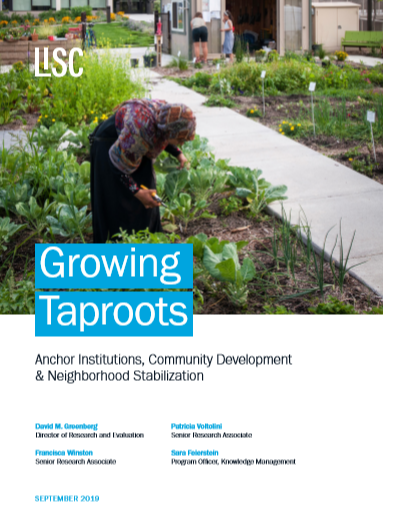A new research paper offers compelling “proof of concept” of how LISC’s strategy, and our collaborations with anchor institutions, are transforming communities in ways that benefit current residents. LISC CEO Maurice A. Jones explains how the study, centered on the Phillips neighborhood of Minneapolis, illuminates the ways anchors can engage with neighbors to promote inclusivity in their backyards and ensure that local voices are listened to—over the long haul.
Top Photo Credit: Bruce Silcox
What does it take to engage hospitals, universities, and major corporations to work with communities in their backyards? And when they become involved, what does it take to make sure these efforts promote equitable and inclusive outcomes – ensuring that communities of color benefit from increased investment that can, in turn, begin to close long-standing income and wealth gaps?
This paper provides some answers to these questions. And in doing so, it demonstrates the impact of LISC’s work.
In the Phillips neighborhood of South Minneapolis, over the course of twenty years, community organizations, resident activists, the public and philanthropic sectors, hospitals and corporations, and Twin Cities LISC engaged in strategic, comprehensive community development efforts.
A statistical analysis of home loan values during the period of our investment, carried out by LISC’s research team, showed values 46% higher in Phillips compared to comparable Minneapolis neighborhoods. And while the local housing market stabilized following the 1990s decline and received a long-term boost, we also found that prices didn’t rise more steeply than in similar, low-income areas. The fact that growth didn’t outpace other areas is another sign that gentrification and displacement did not become widespread, even as commercial corridors were revitalized and safety improved significantly.
The goal of revitalization without displacement is a cherished one in our field. Significant commitments from the public and private sectors helped the Phillips neighborhood advance toward that goal. Consider the following:
- LISC and NEF were involved in about 10 percent of all housing units in Phillips – a remarkable “saturation” of affordable investments. We provided $4.6 million in real estate loans, $10.4 million in grants to build capacity and deliver community-based interventions, and about $56 million in equity investments in affordable housing and commercial facilities.
- At a far greater order of magnitude, the public sector contributed over $1 billion in infrastructure, transportation, housing, and other service investments.
- Hospitals and corporations shared the goal of development without displacement, and supported housing, jobs, and health programs. In addition to these investments, local hospitals employ a significant number of Phillips residents.
Phillips is a special neighborhood. Its immigrant entrepreneurs, Native American activists and service providers, proximity to downtown, anchor institutions, high-capacity community development organizations, and committed public partners all contributed to improvements over two decades. At the same time, residents there still face multiple challenges, including a poverty rate of approximately 40 percent. In response those challenges, LISC has shifted its strategy in Phillips from a focus on housing to investing heavily in job training efforts, often geared to the health field.
But Phillips is not a “special case.” LISC’s very model is predicated on forging local collaborations. Throughout 35 cities, and rural areas in 44 states, we support the conditions for revitalization by supporting local organizations, creating partnerships with the public and private sectors, and making strategic investments. And when major institutions such as hospitals and universities become involved, we make sure that the community has a significant voice in decisions those institutions make that impact the neighborhood. We also work build the capacity of anchors to partner with local groups and create change together.
This paper is a “proof of concept” as to the effectiveness of LISC’s strategy, and to our collaborations with anchors. (We are currently engaged in similar relationships with ProMedica in Toledo, among many others.) It is also a study of how anchors can be involved with communities to promote inclusivity in their backyards, by ensuring that local voices are cultivated and sustained.

This LISC research report provides rigorous evidence about the impact of our investments, and the work of both community organizations and “anchor institutions.” In South Minneapolis, strong community partnerships and commitments from hospitals and corporations stabilized and boosted home values, without contributing to accelerating prices and gentrification.
 Maurice A. Jones, President & CEO, LISC
Maurice A. Jones, President & CEO, LISC
Prior to joining LISC, Maurice was the Secretary of Commerce for the Commonwealth of Virginia, where he managed 13 state agencies focused on the economic needs in his native state. Before that, he was second in command at the U.S. Dept. of HUD, serving as deputy secretary in charge of operations. He has also been Commissioner of Virginia’s Dept. of Social Services and Deputy Chief of Staff to then-Gov. Mark Warner. At the U.S. Treasury Dept. during the Clinton Administration, he managed the CDFI fund. His private sector experience includes top positions at the Virginian-Pilot in Norfolk, a Richmond law firm and a private philanthropy investing in community-based efforts to benefit children in Washington, D.C.
